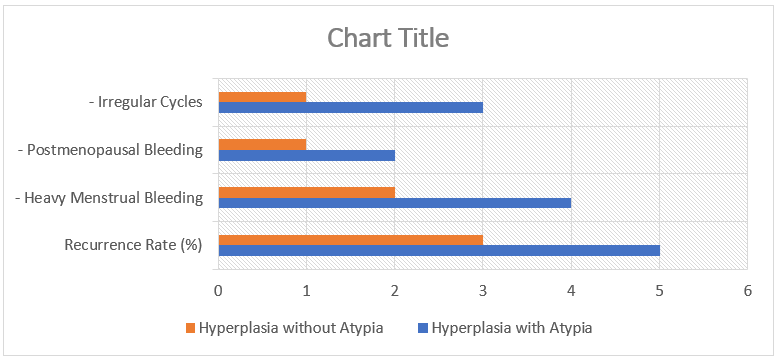AUCTORES
Globalize your Research
Research Article | DOI: https://doi.org/10.31579/2690-4861/609
1Department of Obstetrics and Gynecology, Amrita Institute of Medical Sciences and Research Centre, Amrita Vishwavidyapeetham, Kochi 682041, India.
2Department of Pediatrics Amrita Institute of Medical Sciences and Research Centre, Amrita Vishwavidyapeetham, Kochi 682041, India.
3Health Science Research. Amrita Institute of Medical Sciences and Research Centre, Amrita Vishwavidyapeetham, Kochi 682041, India.
*Corresponding Author: Cherupally Krishnan Nair, Health Science Research. Amrita Institute of Medical Sciences and Research Centre, Amrita Vishwavidyapeetham, Kochi 682041, India.
Citation: Vinita Murali, Sheena P. Kochumon, Pragalya Loganathan, Radhamany K and Cherupally K. Nair, (2025), Comparative Analysis Of Preoperative And Postoperative Findings In Patients With Endometrial Hyperplasia: A Clinical Study, International Journal of Clinical Case Reports and Reviews, 25(2); DOI:10.31579/2690-4861/609
Copyright: © 2025, Cherupally Krishnan Nair. This is an open-access article distributed under the terms of the Creative Commons Attribution License, which permits unrestricted use, distribution, and reproduction in any medium, provided the original author and source are credited.
Received: 07 January 2025 | Accepted: 17 March 2025 | Published: 14 April 2025
Keywords: abnormal uterine bleeding; endometrial hyperplasia; hormone replacement therapy
Aim and Objective: The objective of this study is to compare preoperative and postoperative findings in patients diagnosed with endometrial hyperplasia, focusing on clinical symptoms, histopathological features, co-morbidities, surgical outcomes, and recurrence rates. This analysis aims to identify significant differences between hyperplasia with and without atypia, contributing to improved management strategies and clinical decision-making in patients undergoing treatment for endometrial hyperplasia.
Methodology: This observational study was conducted at Amrita Institute of Medical Sciences in Kochi, Kerala, over two years (July 2019 to July 2021) and approved by the institutional ethical committee. It included 68 women diagnosed with endometrial hyperplasia via endometrial biopsy who were planned for hysterectomy, and excluding those on tamoxifen or hormone replacement therapy. Data on age, menopausal status, time between biopsy and hysterectomy, and histopathological findings were collected and reviewed by a single pathologist, using WHO criteria for classification.
Result: In this study of preoperative and postoperative findings in endometrial hyperplasia, the mean age of patients with hyperplasia with atypia was 49.20 years (n=41) compared to 50.95 years for those without atypia (n=27), with no significant difference in mean endometrial thickness (12.5 mm vs. 11.05 mm, p=0.547). Cystic spaces were more prevalent in the without atypia group (48.1% vs. 24.4%, p=0.063). Postoperatively, complications were low and comparable across groups, with infection rates of 7.3% in atypia and 7.4% in without atypia. The recurrence rates were similar at 12.2% for hyperplasia with atypia and 11.1% for without atypia (p=0.857), indicating that atypia did not adversely affect long-term outcomes. Follow-up symptoms showed a low prevalence of ongoing heavy menstrual bleeding (10.0% for atypia vs. 7.4% for without atypia) and other irregularities, suggesting effective symptom management through surgical intervention.
Conclusion: In conclusion, the study indicates that preoperative and postoperative findings in endometrial hyperplasia, whether atypical or non-atypical, show no significant differences in clinical profiles or outcomes. Both groups exhibited similar mean ages, endometrial thickness, and low rates of postoperative complications. The recurrence rates were also comparable, with 12.2% in the atypical group and 11.1% in the non-atypical group, suggesting that the presence of atypia does not negatively affect long-term outcomes. Overall, these results highlight the effectiveness of surgical intervention for endometrial hyperplasia.
Endometrial hyperplasia is characterized by the thickening of the endometrium, marked by the proliferation of irregularly sized and shaped glands and an increased gland-to-stroma ratio. This condition is a direct precursor to invasive disease and can progress to malignancy if left untreated. It primarily arises due to an imbalance in hormonal regulation, where excess estrogen stimulates endometrial proliferation, while progesterone normally acts to limit this growth. Without proper hormonal balance, the endometrium undergoes a series of architectural and cytological changes, leading to conditions ranging from hyperplasia without atypia to more severe forms like endometrial intraepithelial neoplasia and ultimately, endometrial cancer [1, 2]. A significant incidence rate of 133 per 100,000 per year is observed, particularly post-menopause, highlighting the condition's relevance in gynaecological health [3].
While atypical hyperplasia is more frequently diagnosed in women aged 60 to 64, the true incidence of endometrial hyperplasia may be underreported due to individuals often seeking medical attention only after symptoms have subsided [4]. This condition shares common risk factors with endometrial cancer and is considered a direct precursor in many instances. The rising incidence of endometrial cancer is attributed to factors such as an aging population and increasing obesity rates, despite low public awareness [5, 6, 7]. Currently, there are no routine screening procedures for endometrial hyperplasia or its lesions, making diagnosis reliant on evaluations of abnormal uterine bleeding [8]. The American Cancer Society has concluded that evidence is insufficient to support routine screening in both premenopausal and postmenopausal women, even those at high risk [9].
The primary risk factors for endometrial hyperplasia include elevated estrogen levels and conditions leading to reduced progesterone effects. Non-modifiable factors, such as age, significantly influence the risk, with hyperplasia being most commonly diagnosed in women aged 50 to 54 [10]. Menstrual history also plays a crucial role, with postmenopausal women, those with early menarche or late menopause, and nulliparous women being at higher risk [11]. Obesity is particularly impactful as it correlates with an increased risk of endometrial hyperplasia and cancer; higher body mass index (BMI) is associated with elevated estradiol levels due to increased conversion of androgens to estrogens in adipose tissue ]12, 13]. Other factors, including type II diabetes, chronic low-grade inflammation, and conditions like polycystic ovarian syndrome (PCOS), also contribute to the risk through mechanisms promoting prolonged estrogen exposure and cellular proliferation (14, 15).
Hereditary conditions such as Lynch syndrome and Cowden syndrome further illustrate the genetic underpinnings of endometrial hyperplasia and cancer. Lynch syndrome, associated with mutations in mismatch repair (MMR) genes, presents a lifetime risk of 25-60% for endometrial cancer [16]. Endometrial hyperplasia in Lynch syndrome patients exhibits molecular similarities with endometrial and ovarian carcinomas, reinforcing the notion of early convergence in tumorigenesis [17]. Similarly, Cowden syndrome, linked to germline mutations in the PTEN gene, is characterized by multiple hamartomas and an elevated risk for several cancers, including endometrial cancer [18, 19]. The loss of PTEN function leads to unchecked cellular growth, with early loss of PTEN activity in endometrial hyperplasia being associated with malignancy progression [20]. Understanding these conditions emphasizes the critical need for vigilant monitoring and potential prophylactic measures in at-risk populations [21, 22].
Study Design and Setting
This observational study was conducted at Amrita Institute of Medical Sciences, Kochi, Kerala, India, a tertiary care referral center. The study was approved by the institutional ethical committee and spanned a period of two years, from July 2019 to July 2021. A total of 68 women who reported to the gynaecological outpatient department (OPD) and were diagnosed with endometrial hyperplasia during the evaluation for abnormal uterine bleeding were enrolled in the study.
Inclusion and Exclusion Criteria
The study included women who were diagnosed with endometrial hyperplasia based on endometrial biopsy and were subsequently planned for hysterectomy. All histopathological analyses on endometrial biopsy and hysterectomy were conducted at our institute. Exclusion criteria included women who were planned for hysterectomy based on an endometrial biopsy diagnosis from outside our institute and those who were on tamoxifen or hormone replacement therapy (HRT).
Data collection process: Patients included in the study had reported to the Department of Obstetrics and Gynaecology during the study period and underwent endometrial sampling to evaluate abnormal uterine bleeding. The histopathological diagnosis of endometrial hyperplasia was reviewed and classified according to the World Health Organization (WHO) criteria, which distinguishes endometrial hyperplasia into two categories: with atypia and without atypia.
Data collected for the study included patient age, menopausal status, time interval between endometrial biopsy and hysterectomy, type of endometrial hyperplasia identified in curettage specimens, and the pathological diagnosis in hysterectomy specimens. All preoperative and postoperative pathological specimens were reviewed by a single pathologist. The histopathological findings from the endometrial biopsy were compared and correlated with those from the hysterectomy specimens. The consistency rate was determined by dividing the number of patients with consistent diagnoses on both specimens by the total number of patients included in the study.
Sample Size
The sample size was calculated based on the consistency rate of 45
A total of 68 study participants included in this study. The mean age of patients with hyperplasia with atypia (49.20 years) and without atypia (50.95 years). The endometrial thickness is similar across both groups (12.5 mm vs. 11.05 mm), with no significant difference (p=0.547). The presence of cystic spaces is more common in patients without atypia (48.1%) compared to those with atypia (24.4%). Heavy menstrual bleeding is the most common presenting complaint, particularly in those with atypia (61.8%), indicating that more severe symptoms may correlate with atypical changes. (Table 1)
| Parameter | Hyperplasia with Atypia (n=41) | Hyperplasia without Atypia (n=27) | P Value |
|---|---|---|---|
| Mean Age (years) | 49.20 ± 5.4 | 50.95 ± 6.8 | 0.265 |
| Mean Endometrial Thickness (mm) | 12.5 ± 4.6 | 11.05 ± 5.06 | 0.547 |
| Cystic Spaces Present (%) | 10 (24.4) | 13 (48.1) | 0.063 |
| Presenting Complaints (%) | |||
| - Heavy Menstrual Bleeding | 21 (61.8) | 13 (38.2) | |
| - Postmenopausal Bleeding | 8 (53.3) | 7 (46.7) | |
| - Irregular Cycles | 6 (54.5) | 5 (45.5) | |
| - Amenorrhea | 6 (75) | 2 (25) |
Table 1: Preoperative Findings in Endometrial Hyperplasia
The analysis of co-morbidities, ultrasound findings, and endometrial sampling techniques in relation to the consistency rate revealed no statistically significant associations. Among patients with co-morbidities, 29.7% were in the consistent group, while 41.9% were in the inconsistent group (p=0.294), indicating no significant relationship. Similarly, ultrasound findings such as adenomyosis, fibroids, and their combination did not show any significant differences between the consistent and inconsistent groups, with the combination being slightly more frequent in the consistent group (39.4% vs. 23.1%), but still not significant (p=0.632). Endometrial sampling techniques, including endometrial aspiration and Pipelle biopsy, also showed no significant difference in consistency rates (p=0.423), with 52.8% consistency for aspiration and 60% for Pipelle biopsy. These findings suggest that none of these variables significantly influenced the consistency rate. (Table 2)
| Variable | Consistent (%) | Inconsistent (%) | P Value |
|---|---|---|---|
| Co-Morbidities | 0.294 | ||
| Yes | 11 (29.7%) | 13 (41.9%) | |
| No | 26 (70.3%) | 18 (58.1%) | |
| Ultrasound Findings | 0.632 | ||
| Adenomyosis | 9 (27.3%) | 9 (34.6%) | |
| Fibroid | 9 (27.3%) | 9 (34.6%) | |
| Fibroid + Adenomyosis | 13 (39.4%) | 6 (23.1%) | |
| Ovarian Cyst | 2 (6.1%) | 2 (7.7%) | |
| Endometrial Sampling Techniques | 0.423 | ||
| Endometrial Aspiration (n=53) | 28 (52.8%) | 25 (47.2%) | |
| Pipelle Biopsy (n=15) | 9 (60%) | 6 (40%) |
Table: 2: Co-Morbidities, Ultrasound Findings, and Endometrial Sampling Techniques with Consistency Rate
The rates of postoperative complications are generally low in both groups, indicating that surgical intervention for endometrial hyperplasia is relatively safe. The incidence of infection is similar (7.3% vs. 7.4%), which suggests that the presence of atypia does not influence the likelihood of infection post-surgery. Haemorrhage rates are also comparable, with no significant difference between groups, indicating effective management in both cohorts.The overall low complication rates may reflect careful surgical techniques and patient management in both groups.(Table 3)
| Parameter | Hyperplasia with Atypia (n=41) | Hyperplasia without Atypia (n=27) | P Value |
|---|---|---|---|
| Postoperative Complications (%) | |||
| - Infection | 3 (7.3) | 2 (7.4) | |
| - Hemorrhage | 1 (2.4) | 1 (3.7) | |
| - Other Complications | 2 (4.9) |
|
Table 3: Postoperative Findings in Endometrial Hyperplasia
The recurrence rate for endometrial hyperplasia is similar between groups (12.2% vs. 11.1%), with a p-value of 0.857 indicating no significant difference, suggesting that the presence of atypia does not adversely affect long-term outcomes.Follow-up symptoms reveal that a small percentage
of patients in both groups continue to experience heavy menstrual bleeding and other menstrual irregularities. The low rates of continued symptoms at follow-up indicate that surgical intervention may effectively alleviate the clinical manifestations of endometrial hyperplasia. (Figure1)

Figure 1: Follow-Up Findings
The primary objective of this study was to compare preoperative and postoperative histopathological findings in patients diagnosed with endometrial hyperplasia, focusing on clinical symptoms, co-morbidities, ultrasound findings, sampling techniques, surgical outcomes, and recurrence rates. The results of this analysis provide valuable insights into the diagnostic reliability of endometrial hyperplasia and its progression, with implications for clinical decision-making and patient management.
Our study found that preoperative clinical symptoms, such as heavy menstrual bleeding and postmenopausal bleeding, were common in both hyperplasia with atypia and without atypia, with heavy menstrual bleeding being more frequent in patients with atypia (61.8%). These findings align with previous studies, such as the work by consistency rates ranging from 41.3% to 79.5%, depending on the presence of atypia. We observed higher consistency in patients with atypia (63.7%) than in those without atypia (40.7%), suggesting that atypical hyperplasia may be more reliably diagnosed through preoperative biopsy. The variability in consistency rates across studies highlights the challenges of achieving diagnostic uniformity, potentially due to differences in sampling techniques, interobserver variability, and the nature of the lesions themselves.
Endometrial sampling techniques, including Pipelle biopsy and endometrial aspiration, did not show statistically significant differences in diagnostic accuracy (p=0.423). However, consistency rates for Pipelle biopsy were slightly higher (60%) than for aspiration (52.8%). This finding contrasts with studies such as Navakumar et al., [24] who reported higher consistency rates for both techniques, suggesting that further refinement and standardization in sampling protocols may improve diagnostic accuracy.
Postoperative complications were low across both groups, with no significant difference between hyperplasia with and without atypia. These findings suggest that surgical intervention for endometrial hyperplasia is relatively safe, and that the presence of atypia does not increase the risk of postoperative complications. Our recurrence rates were also similar between groups (12.2% vs. 11.1%, p=0.857), indicating that atypia may not necessarily predict higher recurrence rates.
The study's results also highlight the role of co-morbidities, such as diabetes mellitus and hypertension, in endometrial hyperplasia. While these conditions were prevalent among our patients, they did not significantly impact the consistency rates of preoperative and postoperative histopathological findings. This suggests that factors such as the quality of biopsy samples and pathologist interpretation may play a more significant role in diagnostic accuracy than co-morbid conditions.
In conclusion, this study underscores the importance of reliable preoperative histopathological evaluation in patients diagnosed with endometrial hyperplasia. While consistency rates between preoperative biopsy and postoperative findings were moderate, particularly in cases with atypia, there remains a risk of diagnostic variability. The presence of atypia appears to be associated with more severe clinical symptoms but does not significantly affect surgical outcomes or recurrence rates. Ongoing efforts to standardize diagnostic criteria, improve sampling techniques, and enhance preoperative assessment are essential for optimizing patient management. Future research should focus on larger, multicenter studies to validate these findings and provide clearer guidelines for the diagnosis and treatment of endometrial hyperplasia.
Not applicable.
none.
No conflict of interest for this study.
None.
All authors contributed equally
Clearly Auctoresonline and particularly Psychology and Mental Health Care Journal is dedicated to improving health care services for individuals and populations. The editorial boards' ability to efficiently recognize and share the global importance of health literacy with a variety of stakeholders. Auctoresonline publishing platform can be used to facilitate of optimal client-based services and should be added to health care professionals' repertoire of evidence-based health care resources.

Journal of Clinical Cardiology and Cardiovascular Intervention The submission and review process was adequate. However I think that the publication total value should have been enlightened in early fases. Thank you for all.

Journal of Women Health Care and Issues By the present mail, I want to say thank to you and tour colleagues for facilitating my published article. Specially thank you for the peer review process, support from the editorial office. I appreciate positively the quality of your journal.
Journal of Clinical Research and Reports I would be very delighted to submit my testimonial regarding the reviewer board and the editorial office. The reviewer board were accurate and helpful regarding any modifications for my manuscript. And the editorial office were very helpful and supportive in contacting and monitoring with any update and offering help. It was my pleasure to contribute with your promising Journal and I am looking forward for more collaboration.

We would like to thank the Journal of Thoracic Disease and Cardiothoracic Surgery because of the services they provided us for our articles. The peer-review process was done in a very excellent time manner, and the opinions of the reviewers helped us to improve our manuscript further. The editorial office had an outstanding correspondence with us and guided us in many ways. During a hard time of the pandemic that is affecting every one of us tremendously, the editorial office helped us make everything easier for publishing scientific work. Hope for a more scientific relationship with your Journal.

The peer-review process which consisted high quality queries on the paper. I did answer six reviewers’ questions and comments before the paper was accepted. The support from the editorial office is excellent.

Journal of Neuroscience and Neurological Surgery. I had the experience of publishing a research article recently. The whole process was simple from submission to publication. The reviewers made specific and valuable recommendations and corrections that improved the quality of my publication. I strongly recommend this Journal.

Dr. Katarzyna Byczkowska My testimonial covering: "The peer review process is quick and effective. The support from the editorial office is very professional and friendly. Quality of the Clinical Cardiology and Cardiovascular Interventions is scientific and publishes ground-breaking research on cardiology that is useful for other professionals in the field.

Thank you most sincerely, with regard to the support you have given in relation to the reviewing process and the processing of my article entitled "Large Cell Neuroendocrine Carcinoma of The Prostate Gland: A Review and Update" for publication in your esteemed Journal, Journal of Cancer Research and Cellular Therapeutics". The editorial team has been very supportive.

Testimony of Journal of Clinical Otorhinolaryngology: work with your Reviews has been a educational and constructive experience. The editorial office were very helpful and supportive. It was a pleasure to contribute to your Journal.

Dr. Bernard Terkimbi Utoo, I am happy to publish my scientific work in Journal of Women Health Care and Issues (JWHCI). The manuscript submission was seamless and peer review process was top notch. I was amazed that 4 reviewers worked on the manuscript which made it a highly technical, standard and excellent quality paper. I appreciate the format and consideration for the APC as well as the speed of publication. It is my pleasure to continue with this scientific relationship with the esteem JWHCI.

This is an acknowledgment for peer reviewers, editorial board of Journal of Clinical Research and Reports. They show a lot of consideration for us as publishers for our research article “Evaluation of the different factors associated with side effects of COVID-19 vaccination on medical students, Mutah university, Al-Karak, Jordan”, in a very professional and easy way. This journal is one of outstanding medical journal.
Dear Hao Jiang, to Journal of Nutrition and Food Processing We greatly appreciate the efficient, professional and rapid processing of our paper by your team. If there is anything else we should do, please do not hesitate to let us know. On behalf of my co-authors, we would like to express our great appreciation to editor and reviewers.

As an author who has recently published in the journal "Brain and Neurological Disorders". I am delighted to provide a testimonial on the peer review process, editorial office support, and the overall quality of the journal. The peer review process at Brain and Neurological Disorders is rigorous and meticulous, ensuring that only high-quality, evidence-based research is published. The reviewers are experts in their fields, and their comments and suggestions were constructive and helped improve the quality of my manuscript. The review process was timely and efficient, with clear communication from the editorial office at each stage. The support from the editorial office was exceptional throughout the entire process. The editorial staff was responsive, professional, and always willing to help. They provided valuable guidance on formatting, structure, and ethical considerations, making the submission process seamless. Moreover, they kept me informed about the status of my manuscript and provided timely updates, which made the process less stressful. The journal Brain and Neurological Disorders is of the highest quality, with a strong focus on publishing cutting-edge research in the field of neurology. The articles published in this journal are well-researched, rigorously peer-reviewed, and written by experts in the field. The journal maintains high standards, ensuring that readers are provided with the most up-to-date and reliable information on brain and neurological disorders. In conclusion, I had a wonderful experience publishing in Brain and Neurological Disorders. The peer review process was thorough, the editorial office provided exceptional support, and the journal's quality is second to none. I would highly recommend this journal to any researcher working in the field of neurology and brain disorders.

Dear Agrippa Hilda, Journal of Neuroscience and Neurological Surgery, Editorial Coordinator, I trust this message finds you well. I want to extend my appreciation for considering my article for publication in your esteemed journal. I am pleased to provide a testimonial regarding the peer review process and the support received from your editorial office. The peer review process for my paper was carried out in a highly professional and thorough manner. The feedback and comments provided by the authors were constructive and very useful in improving the quality of the manuscript. This rigorous assessment process undoubtedly contributes to the high standards maintained by your journal.

International Journal of Clinical Case Reports and Reviews. I strongly recommend to consider submitting your work to this high-quality journal. The support and availability of the Editorial staff is outstanding and the review process was both efficient and rigorous.

Thank you very much for publishing my Research Article titled “Comparing Treatment Outcome Of Allergic Rhinitis Patients After Using Fluticasone Nasal Spray And Nasal Douching" in the Journal of Clinical Otorhinolaryngology. As Medical Professionals we are immensely benefited from study of various informative Articles and Papers published in this high quality Journal. I look forward to enriching my knowledge by regular study of the Journal and contribute my future work in the field of ENT through the Journal for use by the medical fraternity. The support from the Editorial office was excellent and very prompt. I also welcome the comments received from the readers of my Research Article.

Dear Erica Kelsey, Editorial Coordinator of Cancer Research and Cellular Therapeutics Our team is very satisfied with the processing of our paper by your journal. That was fast, efficient, rigorous, but without unnecessary complications. We appreciated the very short time between the submission of the paper and its publication on line on your site.

I am very glad to say that the peer review process is very successful and fast and support from the Editorial Office. Therefore, I would like to continue our scientific relationship for a long time. And I especially thank you for your kindly attention towards my article. Have a good day!

"We recently published an article entitled “Influence of beta-Cyclodextrins upon the Degradation of Carbofuran Derivatives under Alkaline Conditions" in the Journal of “Pesticides and Biofertilizers” to show that the cyclodextrins protect the carbamates increasing their half-life time in the presence of basic conditions This will be very helpful to understand carbofuran behaviour in the analytical, agro-environmental and food areas. We greatly appreciated the interaction with the editor and the editorial team; we were particularly well accompanied during the course of the revision process, since all various steps towards publication were short and without delay".

I would like to express my gratitude towards you process of article review and submission. I found this to be very fair and expedient. Your follow up has been excellent. I have many publications in national and international journal and your process has been one of the best so far. Keep up the great work.

We are grateful for this opportunity to provide a glowing recommendation to the Journal of Psychiatry and Psychotherapy. We found that the editorial team were very supportive, helpful, kept us abreast of timelines and over all very professional in nature. The peer review process was rigorous, efficient and constructive that really enhanced our article submission. The experience with this journal remains one of our best ever and we look forward to providing future submissions in the near future.

I am very pleased to serve as EBM of the journal, I hope many years of my experience in stem cells can help the journal from one way or another. As we know, stem cells hold great potential for regenerative medicine, which are mostly used to promote the repair response of diseased, dysfunctional or injured tissue using stem cells or their derivatives. I think Stem Cell Research and Therapeutics International is a great platform to publish and share the understanding towards the biology and translational or clinical application of stem cells.

I would like to give my testimony in the support I have got by the peer review process and to support the editorial office where they were of asset to support young author like me to be encouraged to publish their work in your respected journal and globalize and share knowledge across the globe. I really give my great gratitude to your journal and the peer review including the editorial office.

I am delighted to publish our manuscript entitled "A Perspective on Cocaine Induced Stroke - Its Mechanisms and Management" in the Journal of Neuroscience and Neurological Surgery. The peer review process, support from the editorial office, and quality of the journal are excellent. The manuscripts published are of high quality and of excellent scientific value. I recommend this journal very much to colleagues.

Dr.Tania Muñoz, My experience as researcher and author of a review article in The Journal Clinical Cardiology and Interventions has been very enriching and stimulating. The editorial team is excellent, performs its work with absolute responsibility and delivery. They are proactive, dynamic and receptive to all proposals. Supporting at all times the vast universe of authors who choose them as an option for publication. The team of review specialists, members of the editorial board, are brilliant professionals, with remarkable performance in medical research and scientific methodology. Together they form a frontline team that consolidates the JCCI as a magnificent option for the publication and review of high-level medical articles and broad collective interest. I am honored to be able to share my review article and open to receive all your comments.

“The peer review process of JPMHC is quick and effective. Authors are benefited by good and professional reviewers with huge experience in the field of psychology and mental health. The support from the editorial office is very professional. People to contact to are friendly and happy to help and assist any query authors might have. Quality of the Journal is scientific and publishes ground-breaking research on mental health that is useful for other professionals in the field”.

Dear editorial department: On behalf of our team, I hereby certify the reliability and superiority of the International Journal of Clinical Case Reports and Reviews in the peer review process, editorial support, and journal quality. Firstly, the peer review process of the International Journal of Clinical Case Reports and Reviews is rigorous, fair, transparent, fast, and of high quality. The editorial department invites experts from relevant fields as anonymous reviewers to review all submitted manuscripts. These experts have rich academic backgrounds and experience, and can accurately evaluate the academic quality, originality, and suitability of manuscripts. The editorial department is committed to ensuring the rigor of the peer review process, while also making every effort to ensure a fast review cycle to meet the needs of authors and the academic community. Secondly, the editorial team of the International Journal of Clinical Case Reports and Reviews is composed of a group of senior scholars and professionals with rich experience and professional knowledge in related fields. The editorial department is committed to assisting authors in improving their manuscripts, ensuring their academic accuracy, clarity, and completeness. Editors actively collaborate with authors, providing useful suggestions and feedback to promote the improvement and development of the manuscript. We believe that the support of the editorial department is one of the key factors in ensuring the quality of the journal. Finally, the International Journal of Clinical Case Reports and Reviews is renowned for its high- quality articles and strict academic standards. The editorial department is committed to publishing innovative and academically valuable research results to promote the development and progress of related fields. The International Journal of Clinical Case Reports and Reviews is reasonably priced and ensures excellent service and quality ratio, allowing authors to obtain high-level academic publishing opportunities in an affordable manner. I hereby solemnly declare that the International Journal of Clinical Case Reports and Reviews has a high level of credibility and superiority in terms of peer review process, editorial support, reasonable fees, and journal quality. Sincerely, Rui Tao.

Clinical Cardiology and Cardiovascular Interventions I testity the covering of the peer review process, support from the editorial office, and quality of the journal.

Clinical Cardiology and Cardiovascular Interventions, we deeply appreciate the interest shown in our work and its publication. It has been a true pleasure to collaborate with you. The peer review process, as well as the support provided by the editorial office, have been exceptional, and the quality of the journal is very high, which was a determining factor in our decision to publish with you.
The peer reviewers process is quick and effective, the supports from editorial office is excellent, the quality of journal is high. I would like to collabroate with Internatioanl journal of Clinical Case Reports and Reviews journal clinically in the future time.

Clinical Cardiology and Cardiovascular Interventions, I would like to express my sincerest gratitude for the trust placed in our team for the publication in your journal. It has been a true pleasure to collaborate with you on this project. I am pleased to inform you that both the peer review process and the attention from the editorial coordination have been excellent. Your team has worked with dedication and professionalism to ensure that your publication meets the highest standards of quality. We are confident that this collaboration will result in mutual success, and we are eager to see the fruits of this shared effort.

Dear Dr. Jessica Magne, Editorial Coordinator 0f Clinical Cardiology and Cardiovascular Interventions, I hope this message finds you well. I want to express my utmost gratitude for your excellent work and for the dedication and speed in the publication process of my article titled "Navigating Innovation: Qualitative Insights on Using Technology for Health Education in Acute Coronary Syndrome Patients." I am very satisfied with the peer review process, the support from the editorial office, and the quality of the journal. I hope we can maintain our scientific relationship in the long term.
Dear Monica Gissare, - Editorial Coordinator of Nutrition and Food Processing. ¨My testimony with you is truly professional, with a positive response regarding the follow-up of the article and its review, you took into account my qualities and the importance of the topic¨.

Dear Dr. Jessica Magne, Editorial Coordinator 0f Clinical Cardiology and Cardiovascular Interventions, The review process for the article “The Handling of Anti-aggregants and Anticoagulants in the Oncologic Heart Patient Submitted to Surgery” was extremely rigorous and detailed. From the initial submission to the final acceptance, the editorial team at the “Journal of Clinical Cardiology and Cardiovascular Interventions” demonstrated a high level of professionalism and dedication. The reviewers provided constructive and detailed feedback, which was essential for improving the quality of our work. Communication was always clear and efficient, ensuring that all our questions were promptly addressed. The quality of the “Journal of Clinical Cardiology and Cardiovascular Interventions” is undeniable. It is a peer-reviewed, open-access publication dedicated exclusively to disseminating high-quality research in the field of clinical cardiology and cardiovascular interventions. The journal's impact factor is currently under evaluation, and it is indexed in reputable databases, which further reinforces its credibility and relevance in the scientific field. I highly recommend this journal to researchers looking for a reputable platform to publish their studies.

Dear Editorial Coordinator of the Journal of Nutrition and Food Processing! "I would like to thank the Journal of Nutrition and Food Processing for including and publishing my article. The peer review process was very quick, movement and precise. The Editorial Board has done an extremely conscientious job with much help, valuable comments and advices. I find the journal very valuable from a professional point of view, thank you very much for allowing me to be part of it and I would like to participate in the future!”

Dealing with The Journal of Neurology and Neurological Surgery was very smooth and comprehensive. The office staff took time to address my needs and the response from editors and the office was prompt and fair. I certainly hope to publish with this journal again.Their professionalism is apparent and more than satisfactory. Susan Weiner

My Testimonial Covering as fellowing: Lin-Show Chin. The peer reviewers process is quick and effective, the supports from editorial office is excellent, the quality of journal is high. I would like to collabroate with Internatioanl journal of Clinical Case Reports and Reviews.

My experience publishing in Psychology and Mental Health Care was exceptional. The peer review process was rigorous and constructive, with reviewers providing valuable insights that helped enhance the quality of our work. The editorial team was highly supportive and responsive, making the submission process smooth and efficient. The journal's commitment to high standards and academic rigor makes it a respected platform for quality research. I am grateful for the opportunity to publish in such a reputable journal.
My experience publishing in International Journal of Clinical Case Reports and Reviews was exceptional. I Come forth to Provide a Testimonial Covering the Peer Review Process and the editorial office for the Professional and Impartial Evaluation of the Manuscript.

I would like to offer my testimony in the support. I have received through the peer review process and support the editorial office where they are to support young authors like me, encourage them to publish their work in your esteemed journals, and globalize and share knowledge globally. I really appreciate your journal, peer review, and editorial office.
Dear Agrippa Hilda- Editorial Coordinator of Journal of Neuroscience and Neurological Surgery, "The peer review process was very quick and of high quality, which can also be seen in the articles in the journal. The collaboration with the editorial office was very good."

I would like to express my sincere gratitude for the support and efficiency provided by the editorial office throughout the publication process of my article, “Delayed Vulvar Metastases from Rectal Carcinoma: A Case Report.” I greatly appreciate the assistance and guidance I received from your team, which made the entire process smooth and efficient. The peer review process was thorough and constructive, contributing to the overall quality of the final article. I am very grateful for the high level of professionalism and commitment shown by the editorial staff, and I look forward to maintaining a long-term collaboration with the International Journal of Clinical Case Reports and Reviews.
To Dear Erin Aust, I would like to express my heartfelt appreciation for the opportunity to have my work published in this esteemed journal. The entire publication process was smooth and well-organized, and I am extremely satisfied with the final result. The Editorial Team demonstrated the utmost professionalism, providing prompt and insightful feedback throughout the review process. Their clear communication and constructive suggestions were invaluable in enhancing my manuscript, and their meticulous attention to detail and dedication to quality are truly commendable. Additionally, the support from the Editorial Office was exceptional. From the initial submission to the final publication, I was guided through every step of the process with great care and professionalism. The team's responsiveness and assistance made the entire experience both easy and stress-free. I am also deeply impressed by the quality and reputation of the journal. It is an honor to have my research featured in such a respected publication, and I am confident that it will make a meaningful contribution to the field.

"I am grateful for the opportunity of contributing to [International Journal of Clinical Case Reports and Reviews] and for the rigorous review process that enhances the quality of research published in your esteemed journal. I sincerely appreciate the time and effort of your team who have dedicatedly helped me in improvising changes and modifying my manuscript. The insightful comments and constructive feedback provided have been invaluable in refining and strengthening my work".

I thank the ‘Journal of Clinical Research and Reports’ for accepting this article for publication. This is a rigorously peer reviewed journal which is on all major global scientific data bases. I note the review process was prompt, thorough and professionally critical. It gave us an insight into a number of important scientific/statistical issues. The review prompted us to review the relevant literature again and look at the limitations of the study. The peer reviewers were open, clear in the instructions and the editorial team was very prompt in their communication. This journal certainly publishes quality research articles. I would recommend the journal for any future publications.

Dear Jessica Magne, with gratitude for the joint work. Fast process of receiving and processing the submitted scientific materials in “Clinical Cardiology and Cardiovascular Interventions”. High level of competence of the editors with clear and correct recommendations and ideas for enriching the article.

We found the peer review process quick and positive in its input. The support from the editorial officer has been very agile, always with the intention of improving the article and taking into account our subsequent corrections.

My article, titled 'No Way Out of the Smartphone Epidemic Without Considering the Insights of Brain Research,' has been republished in the International Journal of Clinical Case Reports and Reviews. The review process was seamless and professional, with the editors being both friendly and supportive. I am deeply grateful for their efforts.
To Dear Erin Aust – Editorial Coordinator of Journal of General Medicine and Clinical Practice! I declare that I am absolutely satisfied with your work carried out with great competence in following the manuscript during the various stages from its receipt, during the revision process to the final acceptance for publication. Thank Prof. Elvira Farina

Dear Jessica, and the super professional team of the ‘Clinical Cardiology and Cardiovascular Interventions’ I am sincerely grateful to the coordinated work of the journal team for the no problem with the submission of my manuscript: “Cardiometabolic Disorders in A Pregnant Woman with Severe Preeclampsia on the Background of Morbid Obesity (Case Report).” The review process by 5 experts was fast, and the comments were professional, which made it more specific and academic, and the process of publication and presentation of the article was excellent. I recommend that my colleagues publish articles in this journal, and I am interested in further scientific cooperation. Sincerely and best wishes, Dr. Oleg Golyanovskiy.

Dear Ashley Rosa, Editorial Coordinator of the journal - Psychology and Mental Health Care. " The process of obtaining publication of my article in the Psychology and Mental Health Journal was positive in all areas. The peer review process resulted in a number of valuable comments, the editorial process was collaborative and timely, and the quality of this journal has been quickly noticed, resulting in alternative journals contacting me to publish with them." Warm regards, Susan Anne Smith, PhD. Australian Breastfeeding Association.

Dear Jessica Magne, Editorial Coordinator, Clinical Cardiology and Cardiovascular Interventions, Auctores Publishing LLC. I appreciate the journal (JCCI) editorial office support, the entire team leads were always ready to help, not only on technical front but also on thorough process. Also, I should thank dear reviewers’ attention to detail and creative approach to teach me and bring new insights by their comments. Surely, more discussions and introduction of other hemodynamic devices would provide better prevention and management of shock states. Your efforts and dedication in presenting educational materials in this journal are commendable. Best wishes from, Farahnaz Fallahian.
Dear Maria Emerson, Editorial Coordinator, International Journal of Clinical Case Reports and Reviews, Auctores Publishing LLC. I am delighted to have published our manuscript, "Acute Colonic Pseudo-Obstruction (ACPO): A rare but serious complication following caesarean section." I want to thank the editorial team, especially Maria Emerson, for their prompt review of the manuscript, quick responses to queries, and overall support. Yours sincerely Dr. Victor Olagundoye.

Dear Ashley Rosa, Editorial Coordinator, International Journal of Clinical Case Reports and Reviews. Many thanks for publishing this manuscript after I lost confidence the editors were most helpful, more than other journals Best wishes from, Susan Anne Smith, PhD. Australian Breastfeeding Association.

Dear Agrippa Hilda, Editorial Coordinator, Journal of Neuroscience and Neurological Surgery. The entire process including article submission, review, revision, and publication was extremely easy. The journal editor was prompt and helpful, and the reviewers contributed to the quality of the paper. Thank you so much! Eric Nussbaum, MD
Dr Hala Al Shaikh This is to acknowledge that the peer review process for the article ’ A Novel Gnrh1 Gene Mutation in Four Omani Male Siblings, Presentation and Management ’ sent to the International Journal of Clinical Case Reports and Reviews was quick and smooth. The editorial office was prompt with easy communication.

Dear Erin Aust, Editorial Coordinator, Journal of General Medicine and Clinical Practice. We are pleased to share our experience with the “Journal of General Medicine and Clinical Practice”, following the successful publication of our article. The peer review process was thorough and constructive, helping to improve the clarity and quality of the manuscript. We are especially thankful to Ms. Erin Aust, the Editorial Coordinator, for her prompt communication and continuous support throughout the process. Her professionalism ensured a smooth and efficient publication experience. The journal upholds high editorial standards, and we highly recommend it to fellow researchers seeking a credible platform for their work. Best wishes By, Dr. Rakhi Mishra.

Dear Jessica Magne, Editorial Coordinator, Clinical Cardiology and Cardiovascular Interventions, Auctores Publishing LLC. The peer review process of the journal of Clinical Cardiology and Cardiovascular Interventions was excellent and fast, as was the support of the editorial office and the quality of the journal. Kind regards Walter F. Riesen Prof. Dr. Dr. h.c. Walter F. Riesen.

Dear Ashley Rosa, Editorial Coordinator, International Journal of Clinical Case Reports and Reviews, Auctores Publishing LLC. Thank you for publishing our article, Exploring Clozapine's Efficacy in Managing Aggression: A Multiple Single-Case Study in Forensic Psychiatry in the international journal of clinical case reports and reviews. We found the peer review process very professional and efficient. The comments were constructive, and the whole process was efficient. On behalf of the co-authors, I would like to thank you for publishing this article. With regards, Dr. Jelle R. Lettinga.

Dear Clarissa Eric, Editorial Coordinator, Journal of Clinical Case Reports and Studies, I would like to express my deep admiration for the exceptional professionalism demonstrated by your journal. I am thoroughly impressed by the speed of the editorial process, the substantive and insightful reviews, and the meticulous preparation of the manuscript for publication. Additionally, I greatly appreciate the courteous and immediate responses from your editorial office to all my inquiries. Best Regards, Dariusz Ziora

Dear Chrystine Mejia, Editorial Coordinator, Journal of Neurodegeneration and Neurorehabilitation, Auctores Publishing LLC, We would like to thank the editorial team for the smooth and high-quality communication leading up to the publication of our article in the Journal of Neurodegeneration and Neurorehabilitation. The reviewers have extensive knowledge in the field, and their relevant questions helped to add value to our publication. Kind regards, Dr. Ravi Shrivastava.

Dear Clarissa Eric, Editorial Coordinator, Journal of Clinical Case Reports and Studies, Auctores Publishing LLC, USA Office: +1-(302)-520-2644. I would like to express my sincere appreciation for the efficient and professional handling of my case report by the ‘Journal of Clinical Case Reports and Studies’. The peer review process was not only fast but also highly constructive—the reviewers’ comments were clear, relevant, and greatly helped me improve the quality and clarity of my manuscript. I also received excellent support from the editorial office throughout the process. Communication was smooth and timely, and I felt well guided at every stage, from submission to publication. The overall quality and rigor of the journal are truly commendable. I am pleased to have published my work with Journal of Clinical Case Reports and Studies, and I look forward to future opportunities for collaboration. Sincerely, Aline Tollet, UCLouvain.
